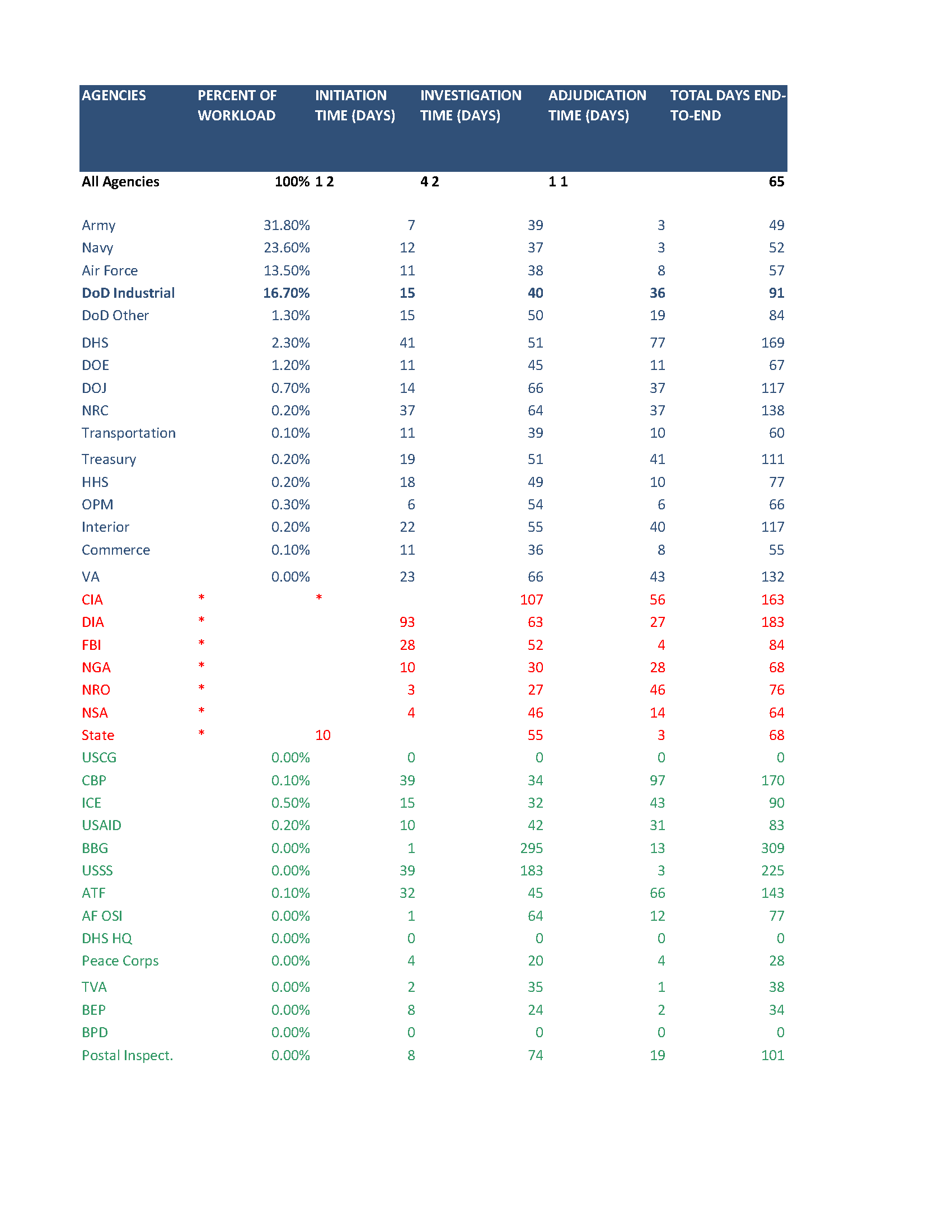In February 2011 the Office of the Director of National Intelligence (ODNI) made its final report on security clearance processing in compliance with Title III of the 2004 Intelligence Reform and Terrorism Prevention Act (IRTPA). Under section 367 of the 2010 Intelligence Authorization Act, beginning this year and annually thereafter, ODNI is required to submit a new more comprehensive report on security clearances to Congress.
The following chart shows the average processing time for the fastest 90% of initial security clearances by agency for the 4th quarter of Fiscal Year 2010 (July to September 2010). Compared to data reported for the 1st quarter FY 2010, overall initial security clearance elapse times have improved about 9%. This improvement was made possible by the military services, which account for almost 70% of all clearances, reducing their average adjudication time by 12 days (about a 70% improvement). The Office of Personnel Management (OPM) contributed to the overall reduction in processing time by shaving about 3 days off their investigations. Other agencies serviced by OPM had mixed results. On average the Intelligence Community (IC) agencies and other agencies that conduct their own investigations experienced increases in processing time.

Source: Office of the Director of National Intelligence, “IRTPA Title II Annual Report for 2010
Notes: Agencies that receive investigative services from OPM are shown in blue and account for a combined total of 94.3 percent of the total workload. Intelligence Community (IC) agencies that conduct their own investigations are shown in red and account for a combined total of 6.3 percent of the total workload. Other agencies that conduct their own investigations are shown in green and account for a combined total of 0.9 percent of the total workload.
In the chart, time is shown as calendar days. “Initiation Time” is “the time in days from the date of submission by the applicant to the receipt date of all information/forms (SF86, releases, fingerprint cards, etc.) required to conduct an investigation by the investigative service provider.” The report provided no explanation for the absence of 4th quarter data for the US Coast Guard, Department of Homeland Security—Headquarters, and Bureau of Engraving and Printing.
Generally Top Secret clearances are taking 65% longer than Confidential and Secret clearances. Overall about 85% of all initial clearance requests are for Confidential/Secret clearances and about 15% are for Top Secret clearances. Because Confidential clearances represent such a small number and involve exactly the same requirements as a Secret clearance, they are not accounted for separately. Government-wide average processing time for the fastest 90% of Top Secret reinvestigation clearances increased from 124 days to 142 days during FY2010.
Processing time for DoD contractor (industrial) initial clearances increased by 13 days in FY2010 and is expected to increase more during FY2011 due to the relocation of the Defense Industrial Security Clearance Office (DISCO) late this summer as part of the BRAC process. Elements of the Defense Office of Hearings and Appeals (DOHA) are also relocating, but their cases always fall within the 10% that are excluded from the reporting requirements of the IRTPA. Beginning in FY2011 the Enhanced Subject Interview (ESI) has been used in place of the Special Interview (SPIN) when derogatory information in a Secret clearance investigation requires case expansion. This will also cause an increase in investigative and adjudicative time. As the Secure Web Fingerprint Transmission (SWFT) system is used by more DoD requestors, reductions in average “initiation time” should occur. SWFT should also reduce the 5% application rejection rate at OPM. Because of the implementation of the new and more complex Standard Form 86 (Questionnaire for National Security Position) this summer, a larger percentage of forms will be rejected by Government offices that review to forms before transmitting them to their investigative service providers. In FY2010 DISCO rejected 4.7% of applications due to errors and omissions.




